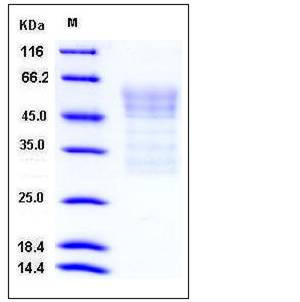Mouse Syndecan-1 / SDC1 / CD138 Protein (His Tag)
AA408134,AA409076,CD138,Sstn,syn-1,Synd,Synd1
- 100ug (NPP3500) Please inquiry
| Catalog Number | P50641-M08H |
|---|---|
| Organism Species | Mouse |
| Host | Human Cells |
| Synonyms | AA408134,AA409076,CD138,Sstn,syn-1,Synd,Synd1 |
| Molecular Weight | The secreted recombinant mouse SDC1 comprises 246 amino acids and has a calculated molecular mass of 26 kDa. As a result of different glycosylation, the apparent molecular mass of rm SDC1 is approximately 45-60 kDa in SDS-PAGE under reducing conditions. |
| predicted N | Gln 17 |
| SDS-PAGE |  |
| Purity | > 80 % as determined by SDS-PAGE |
| Protein Construction | A DNA sequence encoding the extracellular domain of mouse SDC1 (NP_035649.1) (Met 1-Glu 252) was expressed, with a C-terminal polyhistidine tag. |
| Bio-activity | |
| Research Area | Cancer |Invasion microenvironment |Adhesion molecule |Extracelluar matrix |proteoglycans |
| Formulation | Lyophilized from sterile PBS, pH 7.4 1. Normally 5 % - 8 % trehalose and mannitol are added as protectants before lyophilization. Specific concentrations are included in the hardcopy of COA. |
| Background | Syndecan-1 also known as SDC1 and CD138, is the most extensively studied member of the syndecan family. It is found mainly in epithelial cells, but its expression is developmentally regulated during embryonic development. Syndecan-1/SDC1/CD138 has been shown to mediate cell adhesion to several ECM molecules, and to act as a coreceptor for fibroblast growth factors, potent angiogenic growth factors involved also in differentiation. Syndecan-1/SDC1/CD138 expression is reduced during malignant transformation of various epithelia, and this loss correlates with the histological differentiation grade of squamous cell carcinomas, lacking from poorly differentiated tumours. In squamous cell carcinomas of the head and neck, positive syndecan-1 expression correlates with a more favourable prognosis. Experimental studies on the role of Syndecan-1 in malignant transformation have shown that Syndecan-1/SDC1/CD138 expression is associated with the maintenance of epithelial morphology, anchorage-dependent growth and inhibition of invasiveness in vitro. |
| Reference |
